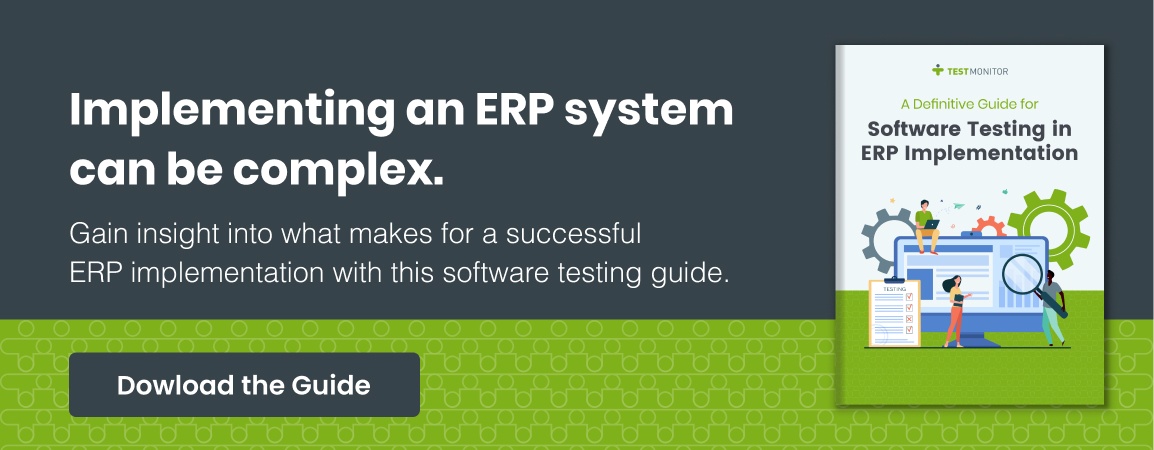5 Tips to Write Better ERP Test Plans
ERP implementations can be stressful, even for experienced technical consultants and IT leaders.
This is because ERP implementation projects are typically large, expansive initiatives that can reinvent, streamline, and simplify how an organization handles its internal operations—from people management to finance and beyond.
However, these projects are also full of risks. They come with high price tags, the need for collaboration across the enterprise, and the potential for misconfigurations, defects, and bugs that hamper the roll-out, adoption, and ROI of the new system.

These are the reasons why it is so important to have a comprehensive and organized ERP test plan that is informed by today’s best practices and leverages industry-leading test management tools.
If you are about to embark on your own ERP implementation and want to ensure your ERP test plan is up to the task, then read on for tips your team needs to consider.
The Key Elements of a Strong ERP Test Plan
Although every team approaches their software testing with their own terminology and templates, ERP test plans generally involve three distinct phases*:
Phase 1: Test Preparation
This phase sets the foundation for a strong testing effort, including identifying the test cases to be run and the QA professionals and end users to be involved in executing the ERP test plan.
Key tasks of this phase include:
- Identify the business processes and scope of the testing (i.e., functional, security, performance).
- Set up the test environments.
- Identify the testers and provide the necessary training and orientation.
- Prepare the test cases, sequence them, and organize them by tester.
- Create any necessary data to be used for inputs to enable the testing.
- Confirm the method to track testing progress and test results.
Phase 2: Test Execution
As the name implies, this phase involves the execution of the manual or automated test cases per the test plan. As test cases are completed, testers log defects and record successful tests, and test managers track the overall status of the testing efforts.
While testing is a critical, and sometimes stressful phase of the test plan, it’s important to remember that:
- Finding bugs is a good thing.
- Software testing confirms defects—but also what is going well.
- Thorough testing saves businesses money.
Testing is important, but it can also be fun! Don’t stress too much about the results of tests, but instead focus on gathering the information you need to make the product better in the long run.
Phase 3: Test Evaluation
After the completion of the testing efforts, the test manager will coordinate the:
- Analysis of the identified defects and successful test cases.
- Assessment of the test plans and cases to refine them for future testing.
- Documentation of the testing process, lessons learned, and next steps.
Because of the complexity and size of ERP implementations, these testing phases will repeat several times until the necessary tests have been completed.
How to Boost the Effectiveness of Your ERP Test Plan
Do you want to go beyond the basics and elevate the effectiveness and efficiency of your ERP test plan? The TestMonitor team has compiled a list of five tips that will help you do just that:
1. Assemble the right testing team.
Find the right mix of testers, including end users to evaluate usability and functionality and QA professionals who know all the software testing types and approaches you intend to execute.
2. Budget enough time.
Launching your ERP system before it is fully tested can lead to implementation failure. It may be tempting to move a project forward before an element is tested, but the future functionality and adoption of a system can be irrevocably harmed.
3. Utilize a modern test management platform.
A modern test management platform can not only reduce the administrative burden of software testing, but also elevate the collaboration, organization, and visibility of your testing. With a leading platform, you can develop test cases, create custom portals for testers, and more, making it well worth the investment.
4. Identify a QA manager.
You might be tempted to have a development team member wear more than one hat. However, QA managers bring the professionalism, experience, and insights needed to help your organization avoid common mistakes and perform comprehensive testing.
5. Be comprehensive.
Don’t assume that tests don’t need to be run based on previous results or even gut feelings. Make sure to include the full range of functional and non-functional testing in your ERP plan, including UAT, security, performance, and integration testing.
Bringing It All Together
Software testing can be a complex and time-consuming process. However, the rewards of implementing a final product that delivers for your customers and achieves business requirements are hard to quantify.
Although we cannot promise an entirely smooth ERP testing process, we do know that the tips in this post—and guidance you’ll find in our other resource, A Definitive Guide for Software Testing in ERP Implementation—are sure to give your team the leg it up they need to cross the finish line strong.
*https://blog.astaqc.com/software-testing-blog/erp-testing-guide-process-types-benefits-and-challenges/






